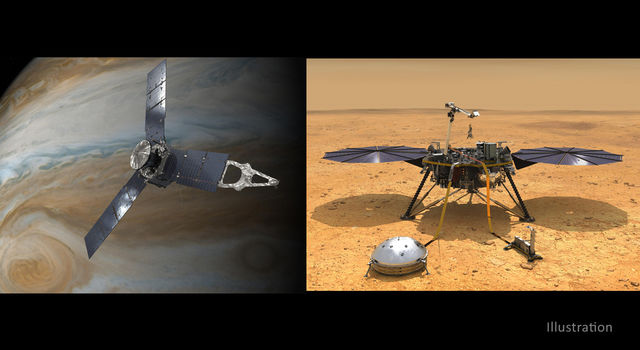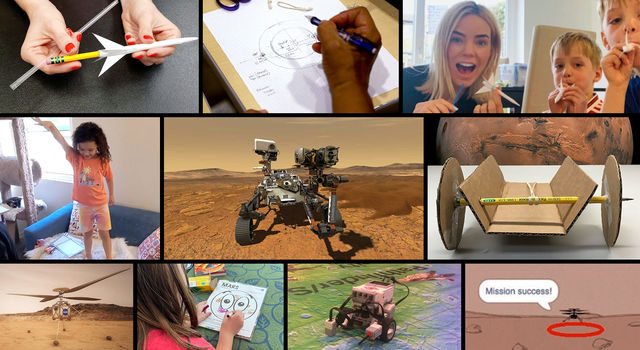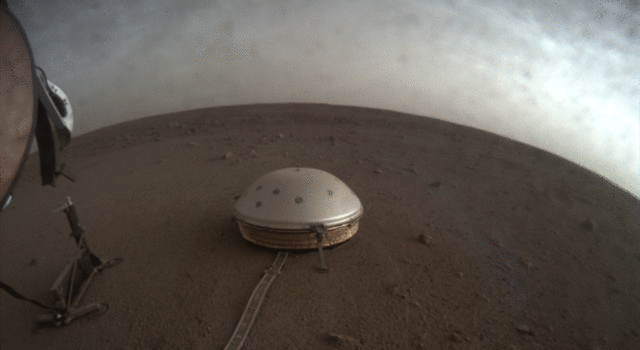Blogs | Dawn Journal | February 24, 2010
February 2010
Dear Dawnthropoids,
Pushing ever farther into space, deeper into the asteroid belt, Dawn is continuing to progress smoothly on its solar system journey.
The spacecraft spends most days climbing away from the Sun atop its pillar of blue-green xenon ions. A day’s thrusting is enough to change the spacecraft’s speed by a very modest 7.3 meters/second (16.3 miles/hour). While such an effect would be entirely inadequate for an interplanetary mission as ambitious as Dawn’s, the extraordinary efficiency of ion propulsion allows the probe to thrust for much more than a day. Although almost all spacecraft coast most of the time, as do planets, moons, and asteroids, this explorer usually maintains a gentle pressure on its orbit, constantly changing it so that it can rendezvous with Vesta next year, leave in 2012, and then rendezvous with Ceres in 2015. Dawn has spent 60% of its time since launch patiently accelerating with the ion propulsion system. It has already managed to change its speed by more than 3.6 kilometers/second (8100 miles/hour), far exceeding the capability of most spacecraft, yet it has a great deal more thrusting ahead. (For a comparison with probes that enter orbit around Mars, visit a previous log.)
In contrast to conventional chemical propulsion systems, ion propulsion achieves its astonishingly high performance by using electrical power to create the thrust. Outfitted with the most powerful solar arrays ever carried on an interplanetary probe, Dawn converts sunlight into the electricity consumed by the ion thrusters. And yet even as its travels take it ever more distant from the luminous source of its electrical power, the effect of the ion thrust becomes greater each day, not less. At the beginning of the mission, a day of thrust yielded only about 6.5 meters/second (14.5 miles/hour). Now, more than 1.8 times farther from the Sun, the acceleration is greater, and by this summer, when Dawn is still farther from the Sun, it will climb to 7.6 meters/second (17.0 miles/hour) every 24 hours. The reason for the paradoxical increase is deceptive, yet simple.
Dawn’s solar arrays are so large that they can produce enough power to operate an ion thruster at the maximum throttle level (as well as all other spacecraft systems) even when twice as far from the Sun as Earth is. Therefore, the propulsion system will not have to be throttled to lower power until the probe is more than 2 astronomical units (AU) from the Sun, a distance it will reach this summer. In the meantime, because the arrays produce excess power, the thrust is independent of the distance to the Sun.
The acceleration depends on more than the thrust, however; the thruster pushes against the spacecraft, so the change in speed depends on the spacecraft’s total mass. A rocket engine (whether powerful and inefficient or soft and efficient) imparts a lower velocity to a more massive craft than to a less massive one. (Gravity, or the absence of it, is not relevant.) This is quite familiar from terrestrial experience. If you throw a baseball with the same force as you throw a shot put, the baseball will depart with a higher speed.
When Dawn began its mission in September 2007, it was about 1218 kilograms (2685 pounds). Since then, it has expended 140 kilograms (309 pounds) of xenon plus about 5 kilograms (11 pounds) of hydrazine from the reaction control system (the system that uses small conventional thrusters to aid in orienting the spacecraft in the zero-gravity of spaceflight). The ion thruster now is pushing against less mass, so the effect of the thrust is greater. As Dawn continues to expel its propellants, it will become still less resistant to the thruster’s efforts to change its speed. In summary, with the thrust staying constant and the mass decreasing, the acceleration is increasing.
The mass will always go down when the ion propulsion or reaction control systems are operated. Once the spacecraft is far enough from the Sun that it needs to reduce the throttle level, the availability of power, and hence the thrust, generally will decline faster than the mass, so the effect of the thrust will diminish. By the end of the mission, a day of thrusting will provide less than half of the change in speed that it does now.
Of course, engineers have been accounting for this since they began designing the project. The entire flight plan from Earth to Vesta (via Mars) and from Vesta to Ceres is based on how much the craft can accelerate throughout its mission.
While the spacecraft will not reach Vesta until July 2011, the Dawn team has been hard at work developing the detailed plans for what it will do there. This month, they initiated the long process of formulating the specific instructions that will be radioed to the probe to carry out those plans, guiding it through all the steps it must follow to get into orbit, to perform the myriad scientific measurements that are planned, to transmit the results to Earth, and to remain healthy and productive in that distant and forbidding environment. The team is beginning with the “approach phase,” which commences in May 2011 and concludes when Dawn has completed thrusting its way to the first orbit from which it will conduct intensive observations in August 2011. (Of course, it will stop occasionally to peer at Vesta as it closes in on the enormous asteroid during the approach phase.) As work on each of the Vesta phases is completed, the team will turn its focus to the next, so by the time Dawn begins its approach, most of the instructions for its year at Vesta will have been prepared.
The commands will be checked and double checked just as they are for carrying out the interplanetary flight. For operating at Vesta so long from now, however, they also are being designed so that shortly before it is time to transmit them to the spacecraft, controllers can update them to account for the exact trajectory the spacecraft is on and other details that may change slightly.
In upcoming logs, we will describe some of the highlights of the plans that are being readied for when the ship reaches its first celestial destination.
To help refine preparations for flying near Vesta and studying it from Dawn’s vantage point, scientists are taking advantage of the convenient alignment between Earth and the protoplanet to observe it with the Hubble Space Telescope on February 25 and 28. The venerable 200-inch (5.1-meter) Hale Telescope on Palomar Mountain in California will be used for other Vesta measurements in April.
While engineers and scientists focus their attentions on Dawn, the ship continues to grow more remote. As we saw in the previous log, after closing in on each other for 14 months, Earth and the spacecraft are now separating again, their independent orbits around the Sun carrying them farther apart. On February 28, Earth will be equidistant from Dawn and the Sun. Readers on that planet will be at the apex of a broad cosmic isosceles triangle, 0.99 AU from both the tremendous star that has governed the solar system for 4.6 billion years and the tiny probe that is quietly and patiently making its way to investigate unexplored alien worlds to help us understand the dawn of the solar system. The third leg, between Dawn and the Sun, will be 1.84 AU long.
Although quite undetectable with all but the most sensitive radio receivers of the Deep Space Network, those who are share in the profundity and the passion for the exploration of the cosmos may wish to gaze upon the spacecraft with their minds’ eyes. It has been farther from Earth before, and other spacecraft have been much farther still, but while it is at the same distance as the Sun, it presents an occasion to reflect upon humankind’s achievements. Dawn’s milestone represents much more than the opportunity to gain fascinating new insights into the solar system and an exciting adventure to reveal vistas previously unseen. At the same distance as the Sun, it symbolizes the extraordinary success of science and engineering. At the same distance as the Sun, it compels us to mediate upon what humankind can accomplish when we are inspired to translate our grand ambitions into action. At the same distance as the Sun, it reminds us that some feats that once were even beyond imagination may be achieved. While physically we are confined to the vicinity of our home planet, the power of uncounted millennia of thoughts, hopes, and dreams combined with persistence, discipline, and tremendous cognitive effort allows us to have an extension of ourselves as far as the Sun. A spacecraft as far as the Sun is a triumph of humble creatures bold enough to reach out into the universe.
To aid in contemplating the nature of such grand undertakings, some readers may wish to peer in the direction of the invisible, distant craft. It is 5.5 degrees northwest of Mars, an easily identified ruby among the gems of the evening sky. (For reference, 5.5 degrees is 11 times the diameter of the Moon or about the width of 3 fingers held together at arm’s length.) It is roughly 2/3 of the way from Mars to the bright star Pollux. As the month ends, your correspondent (reporting on location from Earth) plans to contemplate his view of the Sun during the day and the sky near Dawn in the evening.
This will be the last chance to peer toward the spacecraft while it is this close. For the rest of its mission, and effectively forever, Dawn will be farther from Earth than the Sun. Yet it will remain eternally tied to the planet by virtue of the unique human thirst for knowledge, spirit of adventure, and insatiable yearning to know the cosmos, all of which propel it beyond distant horizons.
Dawn is 0.96 AU (144 million kilometers or 90 million miles) from Earth, or 395 times as far as the Moon and 0.97 times as far as the Sun. Radio signals, traveling at the universal limit of the speed of light, take 16 minutes to make the round trip.
Dr. Marc D. Rayman
8:00 pm PST February 24, 2010
TAGS:DAWN, VESTA, CERES, DWARF PLANET, MISSION, SPACECRAFT







